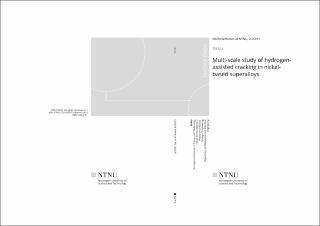Multi-scale study of hydrogen-assisted cracking in nickel-based superalloys
Doctoral thesis
Permanent lenke
https://hdl.handle.net/11250/2648780Utgivelsesdato
2020Metadata
Vis full innførselSamlinger
Sammendrag
Precipitation-hardened nickel-based superalloys are widely used for subsea oil and gas industries. However, they are susceptible to hydrogen embrittlement (HE) when they are used in the hydrogenated environment. There are still many open questions regarding the mechanisms for HE in this alloy system due to the complex microstructure and diversity of test methods. In this PhD thesis, the HE mechanisms of two types of nickel-based superalloys (Alloy 718 and Alloy 725) and a high entropy alloy were thoroughly studied. We brought some novel ideas explaining the failures generated when hydrogen was present by using a combination of slow strain rate tensile test (SSRT), in-situ micropillar compression and in-situ microcantilever bending tests. A series of advanced characterization technique has been exploited to understand the intrinsic relationship between hydrogen and the microstructures, e.g. electron channeling contrast imaging, transmission kikuchi diffraction and atom probe tomography, etc.
It has been shown that electrochemical hydrogen charging could cause slip lines, surface and subsurface cracks, which were induced by the internal stress due to hydrogen concentration gradient near the surface. By choosing a proper hydrogen charging condition, Alloy 718 and Alloy 725 showed different HE behavior. Compared to Alloy 718 where both intergranular and transgranular cracking were observed on the fractography, Alloy 725 showed more susceptible to HE with intergranular fracture dominant behavior. Through atom probe tomography analysis, we figure out that the weakness of grain boundaries (GBs) in Alloy 725 attributes to the decoration of GB precipitates, i.e. (Cr, Mo)-rich precipitates. For GBs without the decoration of precipitates, dislocation transmission is an important factor determining the propensity for intergranular cracking. When hydrogen is present, GBs with high resistance to dislocation slip transmission have a higher probability for cracking due to the synergistic effect of hydrogen and local stress incompatibility, and vice versa. Besides, hydrogen can transform a GB into a barrier for dislocation transmission, especially for low-angle GB and high-angle GB. The generation of microcracks in the grain interior attributes to the hydrogen-assisted defects formation and the pinning effect of hydrogen to dislocation motion. All these works will make contribution to the understanding of the complex phenomenon associated with the interaction of hydrogen with plasticity and damage.
Består av
Paper 1: Lu, Xu; Wang, Dong; Wan, Di; Zhang, Zhenbo; Kheradmand, Nousha; Barnoush, Afrooz. Effect of electrochemical charging on the hydrogen embrittlement susceptibility of alloy 718. Acta Materialia 2019 ;Volum 179. s. 36-48Paper 2: Lu, Xu; Ma, Yan; Wang, Dong. On the study of hydrogen embrittlement behavior of nickel-based superalloys: Alloy 718 vs Alloy 725. This article is awaiting publication and is therefore not included.
Paper 3: Lu, Xu et al. Hydrogen effect on the deformation behavior of Alloy 725 micropillars containing grain boundaries. This article is awaiting publication and is therefore not included.
Paper 4: Lu, Xu; Wang, Dong; Zhiming, Li; Deng, Yun; Barnoush, Afrooz. Hydrogen susceptibility of an interstitial equimolar high-entropy alloy revealed by in-situ electrochemical microcantilever bending test. Materials Science & Engineering: A 2019 ;Volum 762. s. -
